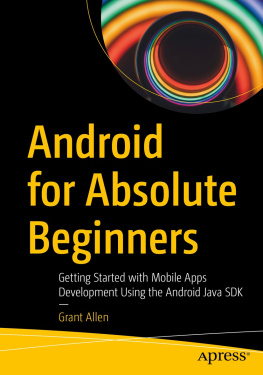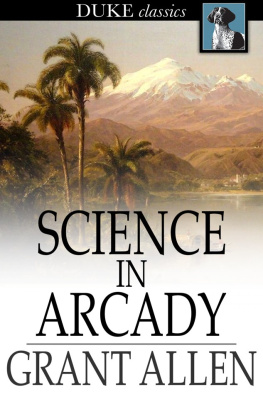Grant Allen - The Evolutionist at Large
Here you can read online Grant Allen - The Evolutionist at Large full text of the book (entire story) in english for free. Download pdf and epub, get meaning, cover and reviews about this ebook. year: 2014, publisher: Duke Classics, genre: Detective and thriller. Description of the work, (preface) as well as reviews are available. Best literature library LitArk.com created for fans of good reading and offers a wide selection of genres:
Romance novel
Science fiction
Adventure
Detective
Science
History
Home and family
Prose
Art
Politics
Computer
Non-fiction
Religion
Business
Children
Humor
Choose a favorite category and find really read worthwhile books. Enjoy immersion in the world of imagination, feel the emotions of the characters or learn something new for yourself, make an fascinating discovery.
- Book:The Evolutionist at Large
- Author:
- Publisher:Duke Classics
- Genre:
- Year:2014
- Rating:4 / 5
- Favourites:Add to favourites
- Your mark:
- 80
- 1
- 2
- 3
- 4
- 5
The Evolutionist at Large: summary, description and annotation
We offer to read an annotation, description, summary or preface (depends on what the author of the book "The Evolutionist at Large" wrote himself). If you haven't found the necessary information about the book — write in the comments, we will try to find it.
Canadian writer Grant Allen gained prominence as an ardent defender of Darwins theory of evolution. In this volume, a select group of Allens writings on the topic of evolution are presented. They range in tone from serious to lighthearted and take the form of essays, poems, and vignettes.
The Evolutionist at Large — read online for free the complete book (whole text) full work
Below is the text of the book, divided by pages. System saving the place of the last page read, allows you to conveniently read the book "The Evolutionist at Large" online for free, without having to search again every time where you left off. Put a bookmark, and you can go to the page where you finished reading at any time.
Font size:
Interval:
Bookmark:

First published in 1881
ISBN 978-1-63421-062-1
Duke Classics
2014 Duke Classics and its licensors. All rights reserved.
While every effort has been used to ensure the accuracy and reliability of the information contained in this edition, Duke Classics does not assume liability or responsibility for any errors or omissions in this book. Duke Classics does not accept responsibility for loss suffered as a result of reliance upon the accuracy or currency of information contained in this book.
Dear Mother, take this English posy, culled.
In alien fields beyond the severing sea:
Take it in memory of the boy you lulled
One chill Canadian winter on your knee.
Its flowers are but chance friends of after years,
Whose very names my childhood hardly knew;
And even today far sweeter in my ears
Ring older names unheard long seasons through.
I loved them allthe bloodroot, waxen white,
Canopied mayflower, trilliums red and pale,
Flaunting lobelia, lilies richly dight,
And pipe-plant from the wood behind the Swale.
I knew each dell where yellow violets blow,
Each bud or leaf the changing seasons bring;
I marked each spot where from the melting snow
Peeped forth the first hepatica of spring.
I watched the fireflies on the shingly ridge
Beside the swamp that bounds the Baron's hill;
Or tempted sunfish by the ebbing bridge,
Or hooked a bass by Shirley Going's mill.
These were my budding fancy's mother-tongue:
But daisies, cowslips, dodder, primrose-hips,
All beasts or birds my little book has sung,
Sit like a borrowed speech on stammering lips.
And still I build fond dreams of happier days,
If hard-earned pence may bridge the ocean o'er;
That yet our boy may see my mother's face,
And gather shells beside Ontario's shore:
May yet behold Canadian woodlands dim,
And flowers and birds his father loved to see;
While you and I sit by and smile on him,
As down grey years you sat and smiled on me.
G. A.
These Essays originally appeared in the columns of the 'St. James'sGazette,' and I have to thank the courtesy of the Editor for kindpermission to republish them. My object in writing them was to make thegeneral principles and methods of evolutionists a little more familiarto unscientific readers. Biologists usually deal with those underlyingpoints of structure which are most really important, and on which alltechnical discussion must necessarily be based. But ordinary peoplecare little for such minute anatomical and physiological details. Theycannot be expected to interest themselves in the flexor pollicislongus, or the hippocampus major about whose very existencethey are ignorant, and whose names suggest to them nothing butunpleasant ideas. What they want to find out is how the outward andvisible forms of plants and animals were produced. They would muchrather learn why birds have feathers than why they have a keeledsternum; and they think the origin of bright flowers far moreattractive than the origin of monocotyledonous seeds or exogenousstems. It is with these surface questions of obvious outward appearancethat I have attempted to deal in this little series. My plan is to takea simple and well-known natural object, and give such an explanation asevolutionary principles afford of its most striking external features.A strawberry, a snail-shell, a tadpole, a bird, a wayside flowertheseare the sort of things which I have tried to explain. If I have notgone very deep, I hope at least that I have suggested in simplelanguage the right way to go to work.
I must make an apology for the form in which the essays are cast, sofar as regards the apparent egotism of the first person. When theyappeared anonymously in the columns of a daily paper, this air ofpersonality was not so obtrusive: now that they reappear under my ownname, I fear it may prove somewhat too marked. Nevertheless, to cut outthe personal pronoun would be to destroy the whole machinery of thework: so I have reluctantly decided to retain it, only begging thereader to bear in mind that the I of the essays is not a realpersonage, but the singular number of the editorial we.
I have made a few alterations and corrections in some of the papers,so as to bring the statements into closer accordance with scientificaccuracy. At the same time, I should like to add that I haveintentionally simplified the scientific facts as far as possible. Thus,instead of saying that the groundsel is a composite, I have said thatit is a daisy by family; and instead of saying that the ascidian larvabelongs to the sub-kingdom Chordata, I have said that it is a firstcousin of the tadpole. For these simplifications, I hope technicalbiologists will pardon me. After all, if you wish to be understood, itis best to speak to people in words whose meanings they know. Definiteand accurate terminology is necessary to express definite and accurateknowledge; but one may use vague expressions where the definite oneswould convey no ideas.
I have to thank the kindness of my friend the Rev. E. PURCELL, ofLincoln College, Oxford, for the clever and appropriate design whichappears upon the cover.
G. A.
In the mud of the Cambrian main
Did our earliest ancestor dive:
From a shapeless albuminous grain
We mortals our being derive.
He could split himself up into five,
Or roll himself round like a ball;
For the fittest will always survive,
While the weakliest go to the wall.
As an active ascidian again
Fresh forms he began to contrive,
Till he grew to a fish with a brain,
And brought forth a mammal alive.
With his rivals he next had to strive,
To woo him a mate and a thrall;
So the handsomest managed to wive,
While the ugliest went to the wall.
At length as an ape he was fain
The nuts of the forest to rive;
Till he took to the low-lying plain,
And proceeded his fellow to knive.
Thus did cannibal men first arrive,
One another to swallow and maul;
And the strongest continued to thrive,
While the weakliest went to the wall.
ENVOY.
Prince, in our civilised hive,
Now money's the measure of all;
And the wealthy in coaches can drive,
While the needier go to the wall.
Sitting on this little rounded boss of gneiss beside the path whichcuts obliquely through the meadow, I am engaged in watching a brigadeof ants out on foraging duty, and intent on securing for the nest threewhole segments of a deceased earthworm. They look for all the worldlike those busy companies one sees in the Egyptian wall-paintings,dragging home a huge granite colossus by sheer force of bone and sinew.Every muscle in their tiny bodies is strained to the utmost as theyprise themselves laboriously against the great boulders which strew thepath, and which are known to our Brobdingnagian intelligence as grainsof sand. Besides the workers themselves, a whole battalion ofstragglers runs to and fro upon the broad line which leads to thehead-quarters of the community. The province of these stragglers, whoseem so busy doing nothing, probably consists in keeping communicationsopen, and encouraging the sturdy pullers by occasional relays of freshworkmen. I often wish that I could for a while get inside those tinybrains, and see, or rather smell, the world as ants do. For there canbe little doubt that to these brave little carnivores here the universeis chiefly known as a collective bundle of odours, simultaneous orconsecutive. As our world is mainly a world of visible objects, theirs,I believe, is mainly a world of olfactible things.
Font size:
Interval:
Bookmark:
Similar books «The Evolutionist at Large»
Look at similar books to The Evolutionist at Large. We have selected literature similar in name and meaning in the hope of providing readers with more options to find new, interesting, not yet read works.
Discussion, reviews of the book The Evolutionist at Large and just readers' own opinions. Leave your comments, write what you think about the work, its meaning or the main characters. Specify what exactly you liked and what you didn't like, and why you think so.












